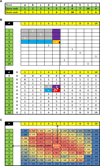FitSearch: a robust way to interpret a yeast fitness profile in terms of drug's mode-of-action
- PMID: 23368702
- PMCID: PMC3549813
- DOI: 10.1186/1471-2164-14-S1-S6
FitSearch: a robust way to interpret a yeast fitness profile in terms of drug's mode-of-action
Abstract
Background: Yeast deletion-mutant collections have been successfully used to infer the mode-of-action of drugs especially by profiling chemical-genetic and genetic-genetic interactions on a genome-wide scale. Although tens of thousands of those profiles are publicly available, a lack of an accurate method for mining such data has been a major bottleneck for more widespread use of these useful resources.
Results: For general usage of those public resources, we designed FitRankDB as a general repository of fitness profiles, and developed a new search algorithm, FitSearch, for identifying the profiles that have a high similarity score with statistical significance for a given fitness profile. We demonstrated that our new repository and algorithm are highly beneficial to researchers who attempting to make hypotheses based on unknown modes-of-action of bioactive compounds, regardless of the types of experiments that have been performed using yeast deletion-mutant collection in various types of different measurement platforms, especially non-chip-based platforms.
Conclusions: We showed that our new database and algorithm are useful when attempting to construct a hypothesis regarding the unknown function of a bioactive compound through small-scale experiments with a yeast deletion collection in a platform independent manner. The FitRankDB and FitSearch enhance the ease of searching public yeast fitness profiles and obtaining insights into unknown mechanisms of action of drugs. FitSearch is freely available at http://fitsearch.kaist.ac.kr.
Figures



References
-
- Lum PY, Armour CD, Stepaniants SB, Cavet G, Wolf MK, Butler JS, Hinshaw JC, Garnier P, Prestwich GD, Leonardson A. et al.Discovering modes of action for therapeutic compounds using a genome-wide screen of yeast heterozygotes. Cell. 2004;116(1):121–137. doi: 10.1016/S0092-8674(03)01035-3. - DOI - PubMed
Publication types
MeSH terms
LinkOut - more resources
Full Text Sources
Other Literature Sources
Molecular Biology Databases

